It can get pretty cold in southern Tasmania in the winter – so why not have a festival with dancing round a bonfire, drinking cider, singing and evoking ancient spirits? The Huon Valley MidWinter Festival will scorch your blues away, for sure.
i Light Marina Bay 2018: Plastic Waste Reinvented as Art
Highlights of Tamar Valley Folk Festival 2018
Rainforest World Music Festival 2015 Brings Memories
Indigenous Music Awards 2010
Dance Workshops, Ancient Traditions and More to Feature in Rainforest World Music Festival 2010
Singapore River Festival 2010 Celebrates History, Heritage With Aerial and Water Shows
Rainforest World Music Festival 2010 to Feature 20 International Artistes from 9-11 July
Miri International Jazz Festival: What's All That Jazz?
World Music Themes at Rainforest World Music Festival 2009
10 July 2009, Kuching.The sounds of World Music are intriguing backed by quaint strains of faraway bands playing with strange-looking musical instruments. What is more fascinating is the meaning behind the songs. We explore more into some of the stories and emotions that are carried in the songs performed at the 12th Rainforest World Music Festival held at the Sarawak Cultural Village.
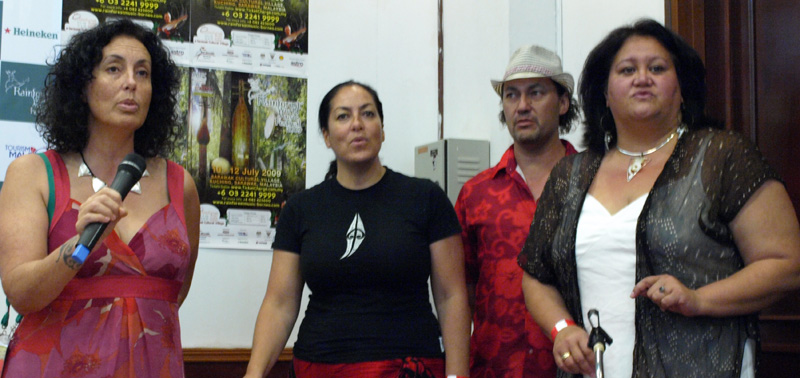
Moana & The Tribe from New Zealand.
For Moana & The Tribe, the Kiwis tell us that their songs are about spirituality, the environment and ancestors. “We see ourselves as guardians of the land and culture, the link between ancestors and the future,” says Moana the singer, composer and leader of the 12-piece band.
Her songs reflect the struggles faced by the Maoris.“Songs are a medium of storytelling; and we use songs to tell of the struggles of our tribes being marginalized.” She refers to the colonization of New Zealand were the Maori culture was chipped at and eroded.
A few songs question the state of things. One song, says Moana, urges “the keeping of traditional Maori names of mountains and rivers alive, formally and legally, not just within our people”. She spoke about the British renaming a mountain that was once called Aoraki to Mt Cook. Aoraki is the highest mountain in New Zealand at 3,754m in the Southern Alps.
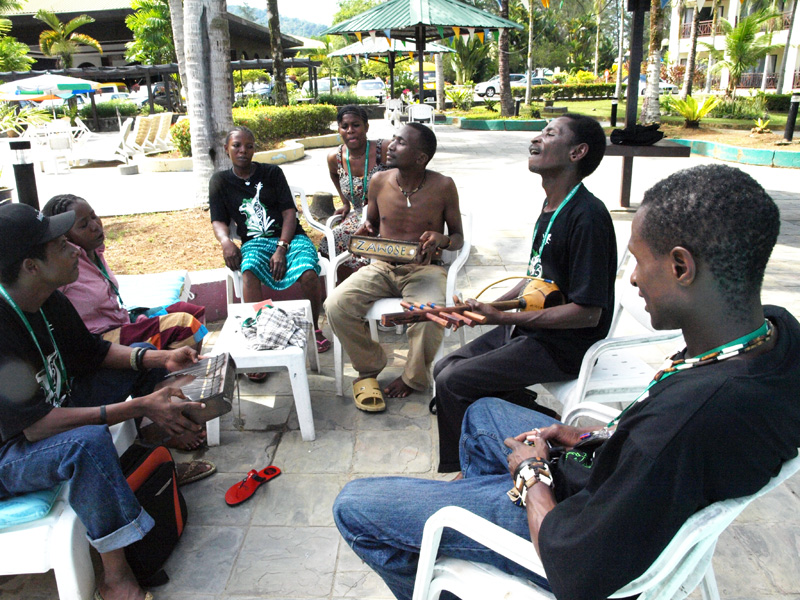
The Zawose family rehearsing poolside.
The song “Moko” addresses the difference between moko (Maori tattoo) and contemporary tattoo, to drive home the point that there is meaning in every indigenous moko carved on the skin of the Maoris. This is not to be dealt with flippantly or misused.
Vasco from Dazkarieh says his music unravels the differentways people relate to each other. He hopes to take a new approach in forging the relations between people. Some songs are about working in the field, and some religious. The Portuguese band revives songs played well before an oppressive Portugal regime 40 yrs ago that banned ethnic music.
The Zawose Family sings in Kigogo, their native dialect in Tanzania, retaining the old flavours of the African country before Swahili was nationalized as a unifying language. The late Hukwe Zawose composed songs that stirred the hearts of the people in taking pride in their country.

Robert Zawose
“We sing about the land, about nature, about people coming together, about life,” smiles Robert Zawose, then points to the tree. “See as we sing, even birds are coming.”
Even while keeping to age-old rhythm, listeners can appreciate their songs about the sufferings involved in the Hiroshima bombing as well as HIV disease. “Sumbu” is about how a woman feels when her child has lost her way, then is struck with memories of her difficult childbirth.
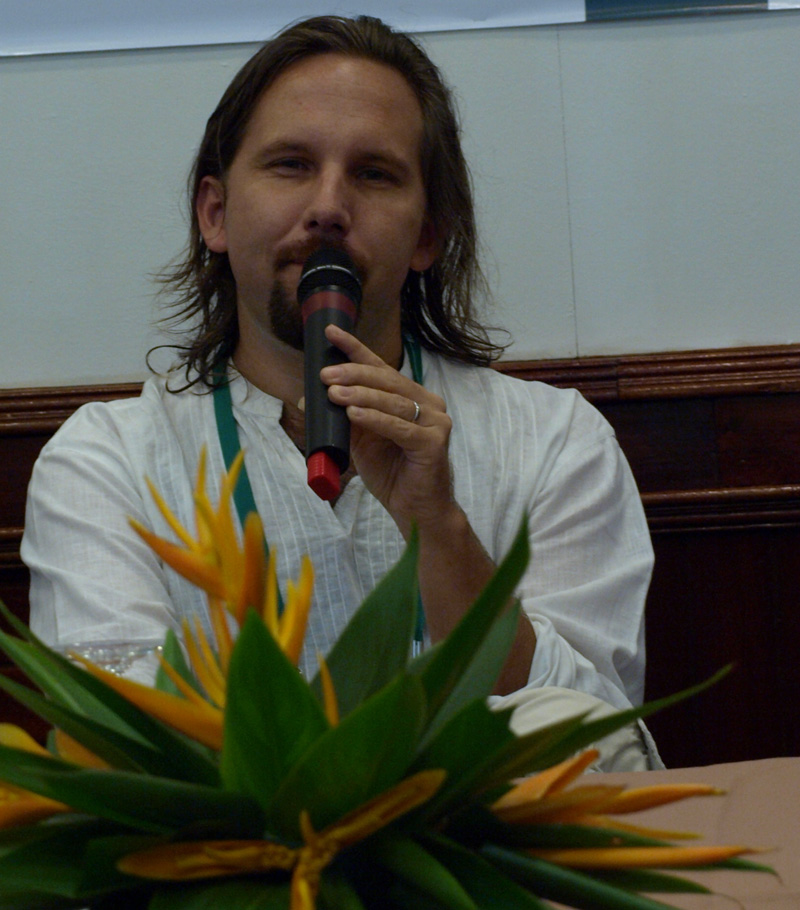
Akasha's James
Akasha from cosmopolitan Malaysia is a “rojak” instrumental band with skills in world music, classical and Latin Jazz. It becomes more interesting when the players who are ethnically Indians, Chinese and Caucasian playtraditional Malay music like the joget, and more contemporary tunes like blues, funk, jazz and Latin.
Guitarist James thinks music need not always have a story or a meaning. “Music has the effect of bringing out a story within people when they listen to it. It pretty much lies in the eye of the beholder; it's not limited by our own vision of it.”
Photos by Mallika Naguran.
See related articles on Gaia Discovery: Interview with festival director Randy Raine-Reusch on 2009 surprising finds; challenges faced by Sarawak Tourism Board before the opening of the 12th Rainforest World Music Festival.
Rainforest World Music Festival Puts Sarawak on the Map
Multi-cultural Sensations at Miri International Jazz Festival 2009
by Mallika Naguran
Singapore, 13 April 2009. Jazz lovers will appreciate Miri as the staging ground of one of the top music festivals in Asia – the Miri International Jazz Festival from 8-9 May 2009. The nature-rich destination of Sarawak is already alluring; add world-class jazz strains to rainforests and national parks, you get a mixture that is both intoxicating and unforgettable.
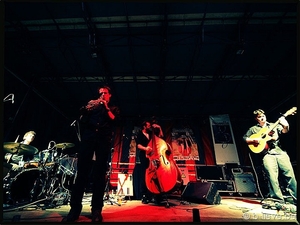
French dudes Dites 34.
The organisers, Sarawak Tourism Board, say that the festival, which is in its fourth year “promises to be another exciting event with wide repertoire of jazz genre”. Indeed the line up looks impressive (see below for full listing) with top bands keeling to kick up some profound blues, fusion, smooth, Latino to world. Leading artistes from around the world will blend heritage strains with musical acumen to get the audience tapping and bobbing away.
The Miri International Jazz Festival 2009 (MIJF) will feature the following performers: Dites 34 (France), Thomson Big Band (Singapore), Jeff Maluleke (South Africa), Alamode (Australia), Steps in Time featuring John Kaizan Neptune (Japan), Bombay Baja (India/England), Rumba Calzada (Canada) and Double Take (Malaysia). The festival is to be held at the Pavilion of the Park City Everly Hotel in Miri.
Miri is located in the northern part of Sarawak and attained its Resort City status in 2005. Often known as the Northern Gateway to Sarawak, the city is a popular base for visitors to explore the nearby national parks including Niah, Loagan Bunut and Lambir Hill national parks.The UNESCO World Heritage Mulu National Park is only a 45- minute flight away.
Jazz Line-up in 2009
Steps In Time featuring John Kaizan Neptune is a multi-cultural band that performs a mix of oriental, traditional and funky beats.John Kaizan Neptune has gained international reputation as the innovator on the Japanese bamboo flute, the Shakuhachi. One-sound-enlightenment shakuhachi blows with complex metre Indian drumming; cool jazz guitar glides with hot snaking Indian violin; funky wild bass grooves with rock steady drum set. At times calm or turbulent, free or calculated, a river of rhythm flows from multi-cultural Steps in Time.
Rumba Calzada was the crowd favourite last year.
Rumba Calzada is making its second appearance at the festival after being voted in survey as the crowd favourite in MIJF 2008. Led by Raphael Geronimo, the band had the crowd going crazy dancing to their blend of their Latino jazz with Afro Cuban rhythm.
Alamode - a six-piece jazz funk powerhouse - is reputed to deliver an amazingly tight and entertaining show.Known to always bring something new to each performance, Alamode is expected to woo the audience at the upcoming MIJF with their original funky tunes.
A leading Indian brass band in Europe, Bombay Baja Brass Band will create a carnival-like atmosphere with their unique style of combining popular Indian melodies with elements of jazz.Performing top Bollywood, Bhangra and Punjabi tunes as well as Indian wedding songs, Bambay Baja Brass Band will definitely entertain MIJF revelers who are Bollywood fans.
Jeff Maluleke is an award-winning South African guitarist, singer and songwriter. Although his music is very much afro-centric in character, Jeff Maluleke has also infuses a range of influences including Western tempo to create a distinct aesthetic that is sure to appeal to all music lovers.
Dites 34 performs a unique blend of traditional French folk music, contemporary jazz and pure energy.Making their Asian debut at the MIJF 2009, members of Dites 34 are no strangers to the music scene having shared the stage with some of the world’s leading artists during their tours of Europe and Mexico.
Thomson Big Band from Singapore.
A household name in Singapore jazz scene, the Thomson Big Band has also created a name for themselves outside the republic after having performed in major jazz festivals and events in Japan, Australia, India and Thailand.
Nearer to home is the Double Take duo of Roger Wang and Mia Palencia who are familiar faces in the local jazz scene in Malaysia. Combining Roger’s jazz guitar wizardry and Mia’s rich and sultry voice, the two will present their music in a pure and intimate form, performing jazz standards and original works.
More information:
Visit Miri International Jazz Festival website for further show and performer details. www.mirijazzfestival.com
Organisers Sawarak Tourism Board www.sarawaktourism.com
Tickets for adults are priced at RM60 per day and RM100 for a two-day ticket. Tickets for children between three and 12 years old are priced at RM30 per day and RM50 for two days. The two-day ticket will only be available until 25 April 2009. Following this date, only daily tickets will be on sale.
Tickets are also available online at www.ticketcharge.com.my.
Getting There:
Malaysia Airlines and AirAsia flies daily to Miri from Kuching, Kota Kinabalu and Kuala Lumpur.
Miri is just one hour flight away from Kuching, the capital city of Sarawak. Kuching, the main gateway to Sarawak, is also accessible via direct flight by Air Asia, Tiger Airways, Silk Air, Batavia Air, Royal Brunei Airways and MAS from Kuala Lumpur, Kota Kinabalu, Singapore, Jakarta, Macau, Pontianak and Brunei Darussalam.
Lip Smacking Malaysia Gourmet Festival
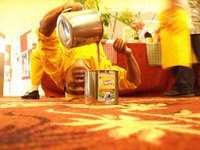
Back flip pulled tea
A trip to Malaysia will not be complete without sampling its authentic cuisine, and there are quite a few, from breakfast to late night supper, the latter to serve as essential tummy liners to pub-crawlers.
Even in the heart of Kuala Lumpur city, you might stumble upon a few finds. Like the mamak (or Indian) shops for hot, crispy roti canai (made of wheat flour, egg and ghee, this is also known in Singapore as roti prata) served with a choice of chicken, fish or dhal curry. Malaysians add a dollop of spicy sambal (chilli paste) in the curry and use their fingers to eat the bread.
Nasi Kandar Pelita along Jalan Ampang and opposite of Chorus Hotel is consistently good with its fast food rendition of Indian Muslim food which includes variations of roti canai (plain, tissue, bom, with egg, banana or shredded meat), all interesting and downright tasty.
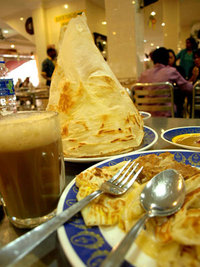
Roti canai in different varieties
Mamak shops serve the popular teh tarik, literally known as pulled tea, which gives it the tantalising froth. Mr Moor Sazali, at the opening of the Malaysian International Gourmet Festival, drew gasps from 2,000 VIP guests as he twisted, twirled and even bent backwards yoga like to create frothy goodness.
Dollops of Malaysian Cuisine
Indeed, this celebration of food is no storm in a teacup for the Malaysian authorities that are bent on spreading the fame of local cuisine to the rest of the world. This includes issuing RM200 million worth of loans pooled to fund restaurant proprietors and investors in setting up bases outside the country.Malaysia has over 350 restaurants operating globally and this is to be upped to 8,000 by year 2015 to forge a stronger gourmet destination identity.
"The challenge is to develop a pool of Malaysian chefs and to export them to the world," said Mr Mohd Rosly Selamat, the chief operating officer of Pempena, a wholly-owned subsidiary of Tourism Malaysia. Mr Selamat shared that an existing programme exists which invites overseas chefs to Malaysia where they get to sample and prepare local dishes. Malaysia Kitchen intends to promote gastronomic by-products such as sauces and condiments to the world, plus local culture and handicrafts (tableware, décor and music) through these restaurants.
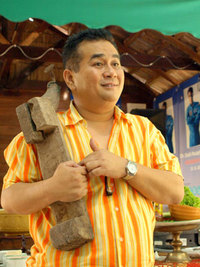
Chef Ismail
Thirty restaurants participated in the month-long international gourmet festival beginning 2 November 2007, which is a step up from a mere 13 in 2001 when it first started. A Malaysia Truly Asian Cuisine showcase saw master chefs dabbling with local ingredients to create a dish that would typify Malaysia.
A definite step in the direction of savouring Malaysia’s heritage I say, as I help myself to another serving of Nescafe tarik (pulled coffee).
Heritage Tantalizes Tastebuds
More can be done, though, like profiling more authentic Malaysian restaurants in tourist literature and websites, banning the use of meat from endangered sources such as shark’s fin especially during gourmet festivals and encouraging local chefs to uphold traditional ways of food preparation and presentation.
Cuisines like and Aunty Aini’s Cafe, Rebung and Enak go a long way in restoring old - in some cases, dying - practices. Authentic dishes are environmental friendly too as ingredients are prepared using manual means and handmade tools as opposed to electrical appliances.
Chef Ismail of Rebung restaurant uses his grandmother’s old coconut grater in his restaurant, partly for sentimental reasons, and the other, to extract the best flavour from the fruit. "Food tastes better when prepared with love," he quipped.
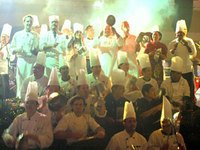
Chefs making music
Give a Thought to the Environment
In authentic Malay cuisines, local produce is used most of the time, depending on seasonal harvests. Meat is gotten from local farms such as the kampong chicken that are free to roam and grow naturally. And where the only steroid used is sunshine.
Eating fresh is one thing. Not buying foreign produce means saying no to mass and over production - what we often see rows after rows of packed frozen and chilled goods in supermarkets. Frozen products also use up more energy in packing, storage and transportation.
If we switched to eating fresh at least half the week by way of buying from the local market or growing own vegetables and herbs, supermarkets would stock up half of existing supplies, there would be fewer cargo flights, fewer delivery trucks on the roads, less exploitation of land for farming, and less carbon and methane emissions.
Returning to basics, going back to simplicity and revisiting age-old practices is something everybody should seriously consider, especially the organisers of the next Malaysian International Gourmet Festival. It will be gentler on Mother Nature, and certainly gentler on our health.
Make a date to visit Malaysia during 2008 Malaysian International Gourmet Festival that takes place all around the country during 1-30 November. Visit www.migf.com for details.
Potos by Mallika Naguran.

